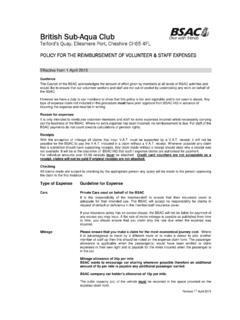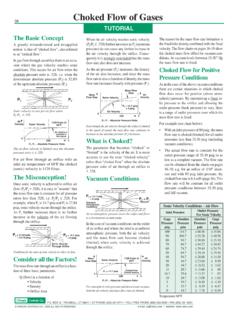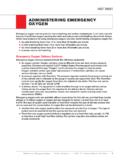Transcription of Breathing lessons Basics of Basics of oxygen therapy
1 , October43 ALTHOUGH COMMON as the air webreathe, oxygen is also a drug thatcan be dangerous if used this article, we ll describe whenoxygen therapy is indicated and howto administer supplemental oxygensafely and appropriately. First, let sreview some basic oxygen transitRoom air consists of about 21% oxy-gen, 78% nitrogen, and 1% othergases, so the fractional concentrationof oxygen in inspired air (FIO2) is21%. By giving supplemental oxy-gen, you can raise the patient s FIO2to as much as 100% oxygen . oxygen is transported to the tis-sues in two ways: About 97% of oxy-gen is bound to hemoglobin, and theother 3% is dissolved in plasma. Thearterial blood gas (ABG) analysismeasures PaO2 the pressure of oxy-gen dissolved in plasma.
2 A value of80 to 100 mm Hg is considered nor-mal, but will increase if the patientreceives a higher oxygen saturation of hemoglobin withoxygen can be measured via pulseoximetry (SpO2) or ABG analysis(SaO2). A normal SpO2or SaO2valueis above 94%. An SaO2or SpO2valuebelow 90% means the PaO2is below60 mm Hg, indicating that the patientisn t adequately to give supplemental oxygen Your patient needs supplemental oxygen ifshe has: documented or suspected hypoxemia, ordeficient oxygenation of the blood, definedas a PaO2below 60 mm Hg, an SaO2 orSpO2below 90%, or either value below thedesirable range for her clinical situation severe trauma acute myocardial infarction procedural sedation or general your patient s need for oxygentherapy by monitoring ABG and SpO2 val-ues and assessing her clinical conditionregularly.
3 Signs of increasing hypoxia(reduced tissue oxygenation despite ade-quate perfusion) include increasingtachypnea and dyspnea, skin colorchanges (pale at first, then cyanotic),increasing tachycardia, hypertension,restlessness, and disorientation. A patient in severe hypoxia will gofrom tachycardia to bradycardia and fromhypertension to hypotension. She llbecome increasingly somnolent, con-fused, lethargic, and, without treatment, most cases, you ll administer higherconcentrations of oxygen as her oxygenneed increases. (Do this carefully inpatients with chronic obstructive pul-monary disease [COPD].) Monitor yourpatient closely and wean her from therapyas soon as possible to avoid oxygen toxicityand absorption atelectasis.
4 Watch for blunt-ing of the respiratory drive, especially inBreathing lessonsBasics of oxygen therapyBasics of oxygen therapySimple face maskPartial rebreather maskNon-rebreather maskVenturi maskFind out how to choose the rightoxygen delivery device for yourpatient s condition. By William C. Pruitt, RRT, CPFT, MBA, and Michael Jacobs, RN, CCRN, CEN, MSNN asal cannulaGARYDONNELLYA closer look at some oxygen delivery devicespatients with COPD. Maintaining an FIO2of 40% or lessusually will prevent these the air thereDevices to deliver oxygen to the patient fall into fourgroups: low flow, conserving, high flow, and enclo-sures. For details about low flow and high flowdevices, see A Closer Look at Some oxygen flow devicessuch as nasal cannulas, simpleface masks, and reservoir masks deliver oxygen atrates below the normal patient inspiratory flow rateof about 30 liters/minute.
5 The patient draws in roomair along with the supplemental oxygen , so the trueFIO2can t be determined and can vary greatly. Forexample, imagine a patient receiving oxygen at 3 liters/minute via nasal cannula. If she s breathinghard and fast, the supplemental oxygen flow will bediluted by the large amount of room air being drawnin, and a relatively low FIO2will result. On the otherhand, if she s taking very slow, deep breaths, very lit-tle room air will be mixed with the supplementaloxygen and her FIO2will be high. Use a nasal cannula for a patient who has adequateventilation and tidal volume but needs more nasal cannula gives her more freedom than amask, which may make her feel claustrophobic.
6 It canalso be used for patients who are mouth low flow device, the simple face mask, isindicated for a patient who needs a little higher con-centration. The higher flow rate keeps her fromrebreathing exhaled carbon dioxide (CO2).Reservoir masks come in two types: a partialrebreather mask and a non-rebreather mask. Similar inappearance, both masks have a reservoir bag that fillswith oxygen , and the bag must be kept inflated. Theseare considered low flow devices, but can deliver higheroxygen concentrations than a simple face , a partial rebreather mask has no one-wayvalves; a non-rebreather mask has a small one-way valveon the outside of the mask and another inside the maskat the top of the bag where it connects to the valves allow expired CO2to leave the devices are designed to decrease theoxygen flow needed to provide adequate using home oxygen systems that require peri-odic refilling (for example, cylinders or liquid oxygensystems) can reduce costs related to the number ofhome visits needed to replenish their supply.
7 (Forinformation about home oxygen without a mask, seeAnother Option for Home oxygen Delivery.)All of these devices can cut oxygen requirements byat least 50%; for example, a patient who needs a flow of3 liters/minute can reduce the flow to liters/minute44 Nursing2003, Volume 33, Number flowNasal cannulaSimple facemaskPartial rebreathermaskNon-rebreathermaskHigh flowVenturi maskOxygen flow(liters/min) considerations Most commonly used oxygen delivery device in hospital, extendedcare, and home health care settings More comfortable than a mask Can irritate nares and skin around ears Patient may find mask uncomfortable and refuse to wear it. Useful when transporting patients Patient may find mask uncomfortable and refuse to wear it.
8 Adjust the flow so the reservoir bag doesn t collapse when the patientbreathes in. Good for short-term (24-hr) therapy for patients needing higher oxygen concentrations Patient may find mask uncomfortable and refuse to wear it. Adjust the flow so the reservoir bag doesn t collapse when the patientbreathes in. Good for short-term (24-hr) therapy for patients needing higher oxygen concentrations Provides highest oxygen concentration without intubation Patient may find mask uncomfortable and refuse to wear it. Useful for patients with chronic carbon dioxide retention, such asthose with chronic obstructive pulmonary diseasewith a conserving device. Newer devices use demandflow or pulsed flow to match the patient s inspiratoryeffort.
9 As the patient starts to inhale, the oxygen flowbegins; as the patient begins to exhale, the flow stops. High flow devicesdeliver oxygen at rates above thenormal inspiratory flow rate and maintain a fixed FIO2regardless of the patient s inspiratory flow and breath-ing pattern. One of the most commonly used systemsis the venturi mask (also called an air-entrainmentmask), which uses a nozzle to accelerate the oxygenflow and mix it with air in a precise ratio. The venturimask can easily deliver from 24% to 50% oxygen byusing different adapters with different-sized nozzleopenings, varying the size of the openings where roomair enters the system (called entrainment ports), orboth. (See A Nose-to-Nose Comparison of Flow Rates.)
10 Aerosol devices produce a fine mist by using a simi-lar oxygen nozzle to entrain air andfluid. The oxygen -enriched mist canbe delivered with a face tent, tra-cheostomy collar, or T-piece. Thesedevices can deliver 24% to 100% oxy-gen and, like the air-entrainmentmask, can exceed the patient s inspira-tory flow at the lower FIO2settings(below 50%). At higher FIO2settings,these devices may need to be run intandem with another aerosol device,using a large-bore Y adapter in theaerosol tubing to join their outputs, tomeet the patient s inspiratory ,typically used for neo-nates and infants, enclose the patient shead or his whole body in an oxygen -enriched atmosphere to treat hypox-emia. A rigid, clear plastic hood is filled with oxygenby the same aerosol device used with the adult aerosolmask, face tent, or T-piece.






